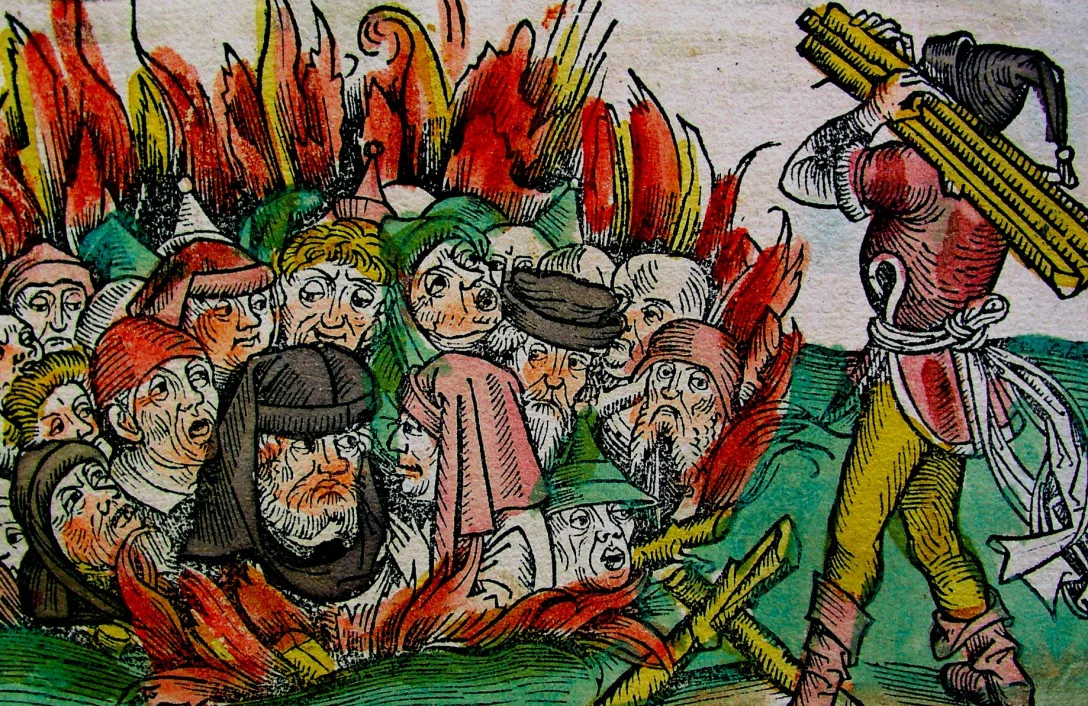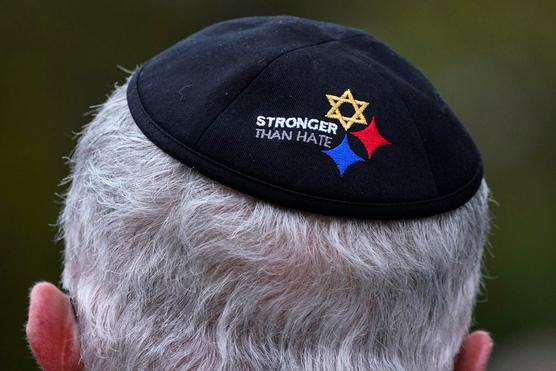 W lutym 1349 r. ponad 2000 Żydów ze Strasburga zostało publicznie spalonych żywcem podczas prześladowań z powodu Czarnej Śmierci. Żydów oskarżono o rozprzestrzenianie zarazy poprzez zatruwanie studni. Od niepamiętnych czasów antysemici promowali takie potworne oszczerstwa przeciwko Żydom, judaizmowi i państwu żydowskiemu.
W lutym 1349 r. ponad 2000 Żydów ze Strasburga zostało publicznie spalonych żywcem podczas prześladowań z powodu Czarnej Śmierci. Żydów oskarżono o rozprzestrzenianie zarazy poprzez zatruwanie studni. Od niepamiętnych czasów antysemici promowali takie potworne oszczerstwa przeciwko Żydom, judaizmowi i państwu żydowskiemu.
 Antysemityzm i potęga wielkiego kłamstwa
Antysemityzm i potęga wielkiego kłamstwa
Jeff Jacoby
Tłumaczenie: Małgorzata Koraszewska
Rok temu można było wierzyć, że tabu dotyczące otwartej nienawiści do Żydów wciąż obowiązywało. Chociaż wybuchy antysemickiej zjadliwości zdarzały się w ostatnich latach z coraz większą i alarmującą częstotliwością i — i pochodziły zarówno z lewej jak i z prawej strony — wydawały się wyjątkiem od powszechnie egzekwowanej reguły. Już tak nie jest. Nawet w Ameryce antysemityzm staje się głównym nurtem, szczególnie wśród młodych. Postholokaustowe wytchnienie dobiegło końca. Antysemityzm powrócił ze zdwojoną siłą, bezczelny i pewny siebie.
Przez tysiąclecia nienawiść do Żydów przybierała przewidywalne wzorce, z których żaden nie był bardziej fundamentalny niż „wielkie kłamstwo”. Antysemici — niezależnie od tego, czy nienawidzą narodu żydowskiego, religii żydowskiej czy państwa żydowskiego — wyrażali swoją nienawiść nie tylko poprzez wyolbrzymianie negatywnych stereotypów, zaprzeczanie niewygodnym prawdom lub powielanie bigoteryjnych obelg. Wielokrotnie promowali również kłamstwa tak potworne i okrutne, tak bezczelnie i agresywnie nieprawdziwe, że ich całkowita nieprawdopodobność daje im iluzję prawdy.
„W wielkim kłamstwie zawsze jest pewna siła wiarygodności” — napisał Adolf Hitler w „Mein Kampf”. Wielu ludzi „mówi małe kłamstwa w małych sprawach” — zauważył, ale „nigdy nie przyszłoby im do głowy, aby wymyślać kolosalne nieprawdy i nie uwierzyliby, że inni mogliby mieć czelność tak haniebnie zniekształcać prawdę”. To jest paradoks i moc wielkiego kłamstwa, zwłaszcza gdy jest powtarzane wystarczająco często: nawet rozsądne umysły stopniowo przyjmują je jako fakt. W końcu, jak podświadomie zakładają, dlaczego urzędnicy państwowi, prasa lub elity społeczne wygłaszałyby tak szokujące i skandaliczne twierdzenia, gdyby nie były prawdziwe?
Hitler rozpoczął wojnę z Żydami od wielkiego kłamstwa, że Niemcy zostały pokonane w I wojnie światowej, ponieważ zostały „ugodzone w plecy” przez żydowskich zdrajców. W rzeczywistości niemieccy Żydzi byli nadzwyczaj lojalni wobec ojczyzny — ponad 100 tysięcy służyło w armii niemieckiej podczas I wojny światowej, a 12 tysięcy zginęło w bitwach. Później pojawiło się jeszcze bardziej niewypowiedziane kłamstwo: groteskowe twierdzenie, że Żydzi byli rasowymi podludźmi, którzy bezcześcili czystość aryjskiej krwi. Dzisiaj wydaje się niewiarygodne, że obywatele Niemiec, najbardziej wyrafinowanego i kulturalnego narodu w Europie, mogli uwierzyć w tak szalone kłamstwa. Ale dziesiątki milionów Niemców w nie uwierzyło. A kiedy naziści przystąpili do ostracyzmu, a następnie eksterminacji europejskich Żydów, działo się to przy gorliwym wsparciu i udziale niezliczonych obywateli niemieckich.
Historia Żydów jest pełna takich śmiercionośnych kłamstw.
Począwszy od XII wieku, Żydzi byli oskarżani o porywanie i mordowanie chrześcijańskich dzieci, aby wykorzystać ich krew do wypieku macy paschalnej. Na mocy tych „oszczerstw o rytuale krwi”, wciąż na nowo przywoływanych w średniowiecznej Europie (i do dziś powtarzanych w świecie muzułmańskim), niezliczeni Żydzi byli więzieni, wypędzani lub mordowani. Oskarżenie to nie było po prostu fałszywe, było to całkowite odwrócenie prawdy. W kulturze żydowskiej spożywanie krwi jest zabronione; w rzeczywistości jest to jeden z pierwszych zakazów w Biblii hebrajskiej. Niezbędnym krokiem w przygotowywaniu koszernego mięsa jest dokładne wypłukanie go z krwi. Mimo to, w to szalone wielkie kłamstwo uwierzyła ogromna liczba Europejczyków.
Podobnie było z wielkim kłamstwem, rozprzestrzenionym podczas niszczycielskiej Czarnej Śmierci w XIV wieku, że Żydzi spowodowali zarazę, zatruwając studnie i źródła. Zamierzali, jak powiedziano, „zabić i zniszczyć całe chrześcijaństwo i mieć władzę nad całym światem”. Oskarżenie było absurdalne, także dlatego, że Żydzi umierali na zarazę, tak jak wszyscy inni. Jednak kłamstwo było tak skuteczne, a antysemicki głód wiary w żydowską winę tak żarliwy, że doprowadziło do złapania i spalenia żywcem tysięcy Żydów.
Z epoki na epokę, wielkie kłamstwa opowiadane o Żydach mutują. Na początku XX wieku Żydzi zostali oskarżeni w niesławnych Protokołach mędrców Syjonu o spisek mający na celu kontrolowanie świata. Po 11 września zostali oskarżeni o planowanie ataków terrorystycznych. Louis Farrakhan od lat wmawia swoim wyznawcom z Narodu Islamu oszczerstwo, że Żydzi są winni „horrorowi transatlantyckiego handlu niewolnikami, niewolnictwu na plantacjach [i] prawom Jima Crowa”. Kwitnący przemysł kłamstw zaprzecza, że kiedykolwiek miał miejsce Holokaust, twierdząc, że najbardziej kompleksowo udokumentowane ludobójstwo w historii jest żydowską fikcją. Wszystkie te kłamstwa są tak szalone, są tak oczywistym odwróceniem rzeczywistości, że żaden zdrowy na umyśle człowiek nie powinien w nie uwierzyć.
A jednak we wszystkie z nich wierzono i nadal wierzy w nie bardzo wielu ludzi, w tym ludzie znani i wpływowi.
W erze nowożytnej najbardziej zabójcze antysemickie wielkie kłamstwa to te, które rozprzestrzeniano na temat Izraela. Państwo żydowskie jest oczerniane od dziesięcioleci jako zbudowane na rasizmie i praktykujące apartheid. Izrael jest oczerniany jako kolonialny intruz bez żadnego uzasadnionego prawa do istnienia. Długo po tym, jak całkowicie wycofał się z Gazy, jest rutynowo potępiany jako „okupant”.
 Człowiek w jarmułce z napisem „Silniejszy niż nienawiść” przed synagogą Drzewo Życia w Pittsburghu, gdzie w 2018 roku doszło do masakry 11 Żydów.
Człowiek w jarmułce z napisem „Silniejszy niż nienawiść” przed synagogą Drzewo Życia w Pittsburghu, gdzie w 2018 roku doszło do masakry 11 Żydów.
Przez dziesięciolecia, kiedykolwiek Izrael był zmuszony walczyć w swojej obronie, antysemici wściekali się, że morduje cywilów z bezmyślnym lekceważeniem przyzwoitości i prawa międzynarodowego. W ciągu roku od 7 października kłamstwa te zostały doprowadzone do fantastycznych skrajności — że Izrael celowo bombarduje szpitale, że świadomie wywołuje głód, a nawet, w zaktualizowanej imitacji negacji Holokaustu, że sfingował masakrę z 7 października w celach propagandowych i spreparował dowody masowych gwałtów i tortur seksualnych.
Największym z tych wielkich kłamstw jest, że Izrael dopuszcza się ludobójstwa na Palestyńczykach. Po raz kolejny, nie jest to po prostu fałsz, ale całkowite odwrócenie rzeczywistości. To Hamas rozpętał ludobójczą przemoc przeciwko Izraelowi 7 października, Hamas, którego przywódcy publicznie przysięgają przeprowadzić „rzeź, eksterminację i zagładę” Żydów, Hamas, którego strategia wyraźnie polega na maksymalizacji liczby ofiar wśród Palestyńczyków. Wiara, że Izrael — który zawsze robił wszystko, aby uniknąć ofiar wśród ludności cywilnej — w rzeczywistości próbuje dokonać eksterminacji narodu palestyńskiego, jest mniej więcej tak logiczna, jak wiara, że Żydzi rozprzestrzeniali Czarną Śmierć, zatruwając wodę pitną.
Ale jeśli chodzi o Żydów, ludzie — nawet wykształceni i wyrafinowani — zawsze byli skłonni uwierzyć w najbardziej potworne wielkie kłamstwa. A horror 7 października, zamiast sprawić, że takie kłamstwa jawiły się jako bardziej szalone niż kiedykolwiek, sprawił, że jeszcze więcej ludzi je przyjęło.
Jeff Jacoby – amerykański prawnik i wieloletni publicysta „Boston Globe”.
Zawartość publikowanych artykułów i materiałów nie reprezentuje poglądów ani opinii Reunion’68,
ani też webmastera Blogu Reunion’68, chyba ze jest to wyraźnie zaznaczone.
Twoje uwagi, linki, własne artykuły lub wiadomości prześlij na adres:
webmaster@reunion68.com




